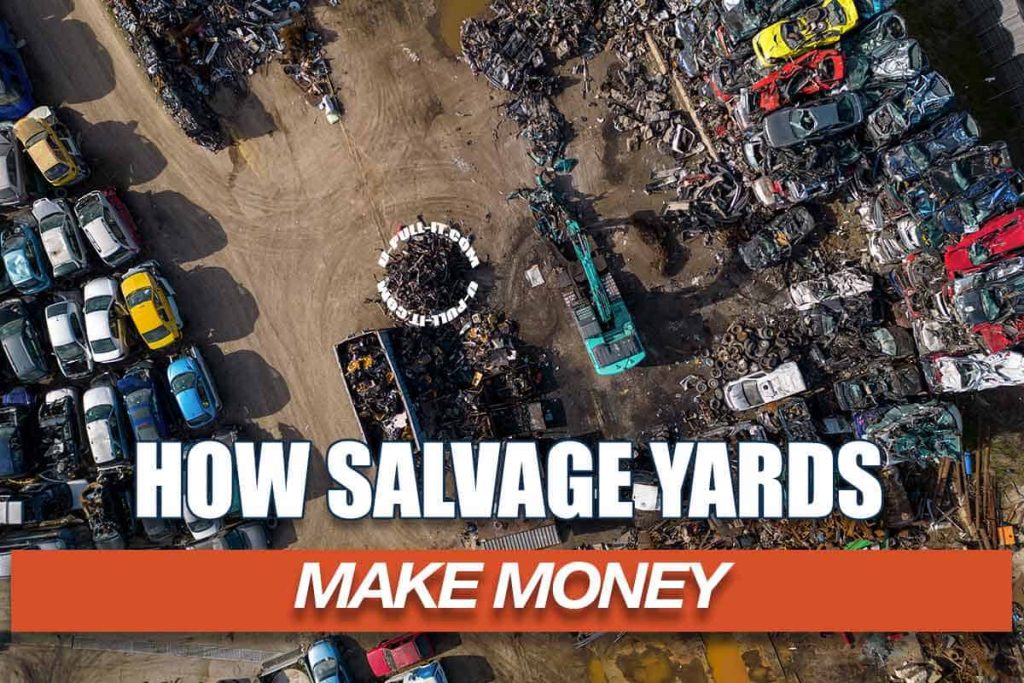As someone who has spent a considerable amount of time in the auto salvage business, I’ve seen firsthand how these operations turn discarded vehicles into profit. If you’ve ever wondered, “how do auto salvage yards make money?” you’re in the right place. In this article, we’ll explore the various ways these businesses generate income, and how they contribute to a more sustainable automotive industry
The Junkyard Profit Margin: The Nitty-Gritty
Now, let’s talk numbers. On average, junkyards pay about $195 per ton, or per 2,000 pounds of ferrous metals. That’s roughly $10 for every 100 pounds of metal. But remember, these prices can change as quickly as the weather, depending on global supply and demand.
When it comes to auto parts, the markup can range from 50 to 70 percent. But if the junk needs to be recycled, the costs go up, and the profits go down. In such cases, the profit margin could drop to 20 to 35 percent.
In a nutshell, the profit margin of junkyards can swing between 20 to 70 percent. It all depends on how you manage the junk, from the moment it enters your yard to the moment it leaves. So, roll up your sleeves and get ready to turn that junk into gold!

How Junkyards Make Money: The Lifecycle of Profit
Junkyards, the unsung heroes of the recycling world, are more than just a resting place for old, damaged, or unwanted vehicles. They are bustling businesses that generate income at every stage of the recycling process. Here’s a deeper dive into the three main ways junkyards turn scrap into cash:
Profit from Acquisition: The Art of the Deal
Junkyards are like the pawn shops of the automotive world. They buy used, old, or damaged cars, trucks, or vans, often at prices lower than their actual worth. It’s like a treasure hunt, where the junkyard owner is the pirate, and the junk cars are the hidden treasure chests.
But here’s the twist: these savvy business owners often expand their profit margins by buying from police auctions. Imagine getting a fleet of cars for the price of one! It’s like hitting the jackpot, but instead of gold coins, you get a pile of cars ready to be stripped down and sold for parts.
Profit from Sorting: The Beauty of Organization
Once the vehicles are in the junkyard, the real fun begins. Each car is like a puzzle, waiting to be taken apart and sorted into different categories based on the damage. This stage is crucial because it determines the value of each part.
The junkyard becomes a bustling marketplace, with different sections for engines, transmissions, body parts, and more. It’s like a giant Lego set, where each piece has its own value. And the best part? The more organized the junkyard, the easier it is for customers to find what they need, leading to more sales and higher profits.
Profit from Sale: The Grand Finale
The grand finale in the lifecycle of a junkyard is the sale of scrap metals, engines, and other vehicle components. This is where the junkyard owner gets to see the fruits of their labor.
Each part sold is like a mini victory, contributing to the overall profit of the business. And the best part? The demand for used auto parts is always high, thanks to DIY mechanics, car enthusiasts, and budget-conscious consumers.
So, the next time you pass by a junkyard, don’t just see a pile of junk. See a thriving business that turns scrap into gold, one car at a time.
Here are the seven magical factors that can turn your junkyard into a goldmine:

Size Matters in the Junkyard World
Just like in a game of Monopoly, the size of your property matters. A sprawling junkyard empire will likely rake in more dough than a small, backyard operation, even if they’re neighbors. The bigger the investment, the bigger the potential payoff.
Location, Location, Location
Location isn’t just crucial for real estate; it’s a game-changer for junkyards too. If your junkyard is in the heart of a bustling city that generates waste like it’s going out of style, you’re in luck! But if you’re in the middle of nowhere, you might have to drive miles for a single rusty bicycle.
The Junk You’re Dealing With
Not all junk is created equal. Some junkyards specialize in car wrecks, while others might be a graveyard for boats or trains. The type of waste you deal with can significantly impact your profit margins. So choose your junk wisely!
The Art of Junkyard Management
Running a junkyard is not just about piling up junk; it’s an art. A well-managed junkyard can turn scrap into gold, while a poorly managed one might just end up being… well, a pile of junk.
The Business Model
The way you run your junkyard can make a world of difference. For instance, a junkyard that also recycles metals might earn differently than one that sells spare parts for cars. And if you’re running a franchise, you might just hit the jackpot!
Marketing: The Secret Sauce
Ever heard of a junkyard commercial? Well, you might need to make one! The more you invest in advertising and marketing, the more customers you’ll attract. Remember, one man’s trash is another man’s treasure!
The Test of Time
The longer your business has been around, the more likely you are to have a loyal customer base. And loyal customers mean steady income. So hang in there, and your junkyard might just turn into a goldmine!

The Business of Buying and Reselling cars for a Profit
One of the primary ways auto salvage yards make money is by buying junk cars and reselling their parts. When a car is no longer functional or not worth repairing, it’s often sold to a salvage yard. These businesses see value where others might see waste. They purchase these vehicles, often for a fraction of their operational value, with the intention of reselling the usable parts.
At U-Pull-It, we buy junk cars of all makes and models. We then inventory the usable parts and make them available to customers at a fraction of the cost of new parts. This is a win-win situation for both the salvage yard and the customer. The yard makes a profit from the parts sold, and the customer saves money on their car repairs.
The Demand for Used Car Parts
There’s a significant demand for used car parts, which is another factor that contributes to the profitability of auto salvage yards. Many car owners prefer to buy used parts due to the cost savings. Plus, used parts are often just as good as new ones, especially for older cars where new parts may be harder to find or more expensive.
At U-Pull-It, we have a vast inventory of used car parts. Customers can visit our local U-Pull-It auto salvage yard to find the parts they need. We also offer an online inventory for convenience.
The Scrap Metal Business
Another way auto salvage yards make money is by selling scrap metal. When a car is brought to the yard, not all parts can be resold. The remaining metal, however, can be sold to scrap metal companies. This includes everything from the car’s body to its engine parts.
At U-Pull-It, we also buy scrap metals. We understand the value of these materials and strive to recycle as much as possible. You can learn more about this aspect of our business here.
Factors That Determine How Much Money Junkyards Make
Several factors can significantly impact your earnings in the junkyard business:
- Size of your junkyard: Larger junkyards with more land can accommodate more junk vehicles and parts, thus generating more money.
- Junkyard location: The location of your junkyard matters a lot. You may likely make less money if your junkyard is located in an already saturated area or in areas with low demand for scrap cars.
- Types of junks your junkyard deals in: Your earnings will depend on the extent of junks your business deals in. You can also expand into motorcycles, boats, bicycles, small airplanes, and train junks.
- Junkyard management: The type of management system existing in your junkyard can affect your profit. Under proper and progressive management, you can make a fortune buying and selling scrap cars.
How To Start a Junkyard Business
Starting a junkyard, scrap, or salvage yard business requires all of the important background research you’d do with other businesses. You need to carefully research your state or community and the existing junkyard businesses. Determining the level of competition can help you decide what to do and how to approach the business. After researching the industry and determining your unique selling potential (USP), you can then move up the line. The steps to start your junkyard business include planning your junkyard business, registering your business, opening a business account for your junkyard, setting up business accounting, obtaining all necessary permits and licenses, and getting business insurance.
Frequently Asked Questions
How does pricing work at a junkyard?
Pricing at a junkyard is determined by several factors, including the condition of the car, the demand for its parts, and the current price of scrap metal. Some junkyards also have a flat rate for all cars, regardless of condition or model.
How do I start a salvage business?
Starting a salvage business requires a good understanding of the industry, a suitable location, and the necessary permits and licenses. You’ll also need to source for junk cars, which can be done through auctions, private sellers, or insurance companies.
How Do Junkyards Make Money?
Junkyards make money by buying junk cars at a low price and then selling the usable parts to individuals or businesses. They also sell the scrap metal from the cars to recycling companies.
How to Make Money With a Junkyard
You can make money with a junkyard by selling used car parts, selling scrap metal, and offering services such as towing and car crushing. Some junkyards also make money by selling cars that can be repaired and put back on the road.
How to Start a Junkyard Business
Starting a junkyard business requires a good location, the necessary permits and licenses, and a source of junk cars. You’ll also need to advertise your business to attract customers.
How to Make Money Finding Auto Parts in Salvage Yards
You can make money finding auto parts in salvage yards by buying the parts at a low price and then selling them for a profit. This requires a good knowledge of cars and their parts, as well as the ability to negotiate prices.
How Do Junkyards Make Money? (Smart Ways They Profit)
Junkyards make money in several smart ways, including selling used car parts, selling scrap metal, and offering services such as towing and car crushing. They also make money by buying junk cars at a low price and then selling the usable parts.
Do junk yards make a lot of profit?
The amount of profit a junkyard makes can vary widely, depending on factors such as the location of the junkyard, the demand for used car parts, and the current price of scrap metal.
How Do Junkyards Work?
Junkyards work by buying junk cars, stripping them of usable parts, and selling those parts to individuals or businesses. They also sell the scrap metal from the cars to recycling companies.
What is the most profitable part of a junk car?
The most profitable part of a junk car can vary, but generally, the catalytic converter is considered the most valuable part due to the precious metals it contains, such as platinum, palladium, and rhodium.
In conclusion, auto salvage yards or junkyards play a crucial role in the automotive industry. They provide a solution for unwanted cars, contribute to environmental sustainability, and offer affordable parts for car owners. The business model of a junkyard is quite profitable, given the demand for used car parts and the value of scrap metal. If you’re considering starting a junkyard business, it’s essential to understand the industry, the demand in your area, and the necessary steps to get started.




